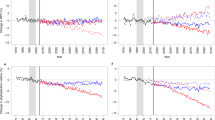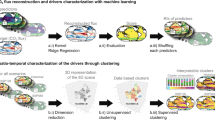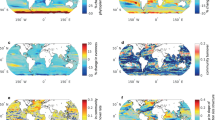Abstract
Globally, anthropogenic climate change is threatening marine species. However, whether and how global marine phytoplankton, which represent the base of marine food webs, will exceed their tipping points under multiple climate factors remain unclear. Here, by establishing machine learning models, we identified the tipping points of global marine phytoplankton production and resistance under eight environmental stressors. Phytoplankton production and resistance are affected by multiple factors and the temperature and partial pressure of carbon dioxide dominate the risks for reaching their tipping points. If the current emission scenario continues, 50% (40–61% at 90% confidence) and 41% (2–80% at 90% confidence) of tropical areas would reach the tipping points of ongoing phytoplankton production and resistance decline, respectively, in 2100. Compared with single- or few-factor studies, machine learning (for example, ensemble machine learning) provides a powerful and realistic solution for policy-makers facing large-scale ecological responses to global climate changes under multiple environmental stressors.
This is a preview of subscription content, access via your institution
Access options
Access Nature and 54 other Nature Portfolio journals
Get Nature+, our best-value online-access subscription
$29.99 / 30 days
cancel any time
Subscribe to this journal
Receive 12 print issues and online access
$209.00 per year
only $17.42 per issue
Buy this article
- Purchase on Springer Link
- Instant access to full article PDF
Prices may be subject to local taxes which are calculated during checkout




Similar content being viewed by others
Data availability
The CHL data are available from the NASA Earth Observations (https://neo.gsfc.nasa.gov/view.php?datasetId=MY1DMM_CHLORA). The partial pressure of carbon dioxide at the sea surface data are available in the NOAA National Centers for Environmental Information (NCEI Accession 0160558) v.5.5. The NPP data are available at the Ocean Productivity site (http://orca.science.oregonstate.edu/1080.by.2160.monthly.xyz.vgpm.m.chl.m.sst.php). The PAR data are available in the OceanColor data website (monthly 4 km resolution, MODIS-Aqua L3m, https://oceandata.sci.gsfc.nasa.gov/). The mean nutrient concentrations, including the nitrate, silicate and phosphate concentrations, are available in the World Ocean Atlas 2018 climatological fields (https://www.ncei.noaa.gov/access/world-ocean-atlas-2018/). The salinity and sea surface temperature data are available from the IAP Ocean Gridded Product (http://www.ocean.iap.ac.cn/). The phytoplankton data are available in the PANGAEA (https://doi.pangaea.de/10.1594/PANGAEA.904397). The future climatic changes for T, salinity, \({{{\mathrm{NO}}}}_3^ -\) and NPP of RCP 2.6 and RCP 8.5 are available in the IPCC report on Climate Change 2013 (https://www.ipcc.ch/report/ar5/wg1/). The future climatic changes for \(p_{\rm{{CO}_{2}}}\) in RCP 2.6 and RCP 8.5 are available in the RCP database (v.2.0.5, https://tntcat.iiasa.ac.at/RcpDb/). The projected tendencies of \({{{\mathrm{PO}}}}_4^{3 - }\) and \({{{\mathrm{NO}}}}_3^ -\) refer to a previous study84. Compiled data are available for others to use on figshare66, licensed under CC BY 4.0. Confidence intervals for the analysis are provided in the Supplementary Data. Source data are provided with this paper.
Code availability
The custom-written basin hopping code, R software and Python codes are available on figshare66, licensed under CC BY 4.0.
References
Trisos, C. H., Merow, C. & Pigot, A. L. The projected timing of abrupt ecological disruption from climate change. Nature 580, 496–501 (2020).
Wang, Z. et al. Environmental stability impacts the differential sensitivity of marine microbiomes to increases in temperature and acidity. ISME J. 15, 19–28 (2021).
Aricò, S. et al. Integrated Ocean Carbon Research: A Summary of Ocean Carbon Research, and Vision of Coordinated Ocean Carbon Research and Observations for the Next Decade (UNESCO, 2021).
Mausz, M. et al. High CO2 concentration and iron availability determine the metabolic inventory in an Emiliania huxleyi-dominated phytoplankton community. Environ. Microbiol. 2, 3863–3882 (2020).
Boyce, D. G., Lewis, M. R. & Worm, B. Global phytoplankton decline over the past century. Nature 466, 591–596 (2010).
Logan, C. A., Dunne, J. P., Ryan, J. S., Baskett, M. L. & Donner, S. D. Quantifying global potential for coral evolutionary response to climate change. Nat. Clim. Change 11, 537–542 (2021).
O'Hara, C. C., Frazier, M. & Halpern, B. S. At-risk marine biodiversity faces extensive, expanding, and intensifying human impacts. Science 372, 84–87 (2021).
Ritchie, P. D. L., Clarke, J. J., Cox, P. M. & Huntingford, C. Overshooting tipping point thresholds in a changing climate. Nature 592, 517–523 (2021).
Tornqvist, T. E., Jankowski, K. L., Li, Y. X., Gonzalez & J, L. Tipping points of Mississippi Delta marshes due to accelerated sea-level rise. Sci. Adv. 6, 5512 (2020).
Bonan, G. B. & Doney, S. C. Climate, ecosystems, and planetary futures: the challenge to predict life in Earth System Models. Science 359, 8328 (2018).
Heinze, C. The quiet crossing of ocean tipping points. Proc. Natl Acad. Sci. USA 118, e2008478118 (2021).
IPCC. Climate Change 2013: The Physical Science Basis (eds Stocker, T. F. et al.) (Cambridge Univ. Press, 2013).
Zhang, X., Wan, H., Zwiers, F. W., Hegerl, G. C. & Min, S. Attributing intensification of precipitation extremes to human influence. Geophys. Res. Lett. 40, 5252–5257 (2013).
Boyd, P. W., Lennartz, S. T., Glover, D. M. & Doney, S. C. Biological ramifications of climate-change-mediated oceanic multi-stressors. Nat. Clim. Change 5, 71–79 (2015).
Barton, A. D., Irwin, A. J., Finkel, Z. V. & Stock, C. A. Anthropogenic climate change drives shift and shuffle in North Atlantic phytoplankton communities. Proc. Natl Acad. Sci. USA 113, 2964–2969 (2016).
Berdugo, M. et al. Global ecosystem thresholds driven by aridity. Science 367, 787–790 (2020).
Cai, Y., Lenton, T. M. & Lontzek, T. S. Risk of multiple interacting tipping points should encourage rapid CO2 emission reduction. Nat. Clim. Change 6, 520–525 (2016).
Dutkiewicz, S., Boyd, P. W. & Riebesell, U. Exploring biogeochemical and ecological redundancy in phytoplankton communities in the global ocean. Glob. Change Biol. 27, 1196–1213 (2021).
Flombaum, P., Wang, W. L., Primeau, F. W. & Martiny, A. C. Global picophytoplankton niche partitioning predicts overall positive response to ocean warming. Nat. Geosci. 13, 116–120 (2020).
Zhou, Q., Gibson, C. E. & Foy, R. H. Long-term changes of nitrogen and phosphorus loadings to a large lake in north-west Ireland. Water Res. 34, 922–926 (2000).
Wang, H. & Zheng, H. Model Validation, Machine Learning (eds Dubitzky, W. et al.) (Springer, 2013).
Righetti, D., Vogt, M., Zimmermann, N. E., Guiry, M. D. & Gruber, N. PhytoBase: a global synthesis of open-ocean phytoplankton occurrences. Earth Syst. Sci. Data 12, 907–933 (2020).
Diepenbroek, M. et al. PANGAEA-an information system for environmental sciences. Comput. Geosci. 28, 1201–1210 (2002).
Ban, Z. et al. Machine learning predicts the functional composition of the protein corona and the cellular recognition of nanoparticles. Proc. Natl Acad. Sci. USA 117, 10492–10499 (2020).
Chung, Y. et al. Ensemble machine learning-based algorithm for electric vehicle user behavior prediction. Appl. Energy 254, 113732 (2019).
Forzieri, G. et al. Emergent vulnerability to climate-driven disturbances in European forests. Nat. Commun. 12, 1081 (2021).
Righetti, D. et al. Global pattern of phytoplankton diversity driven by temperature and environmental variability. Sci. Adv. 5, eaau6253 (2019).
Van Heerwaarden, B. & Sgrò, C. M. Male fertility thermal limits predict vulnerability to climate warming. Nat. Commun. 12, 2214 (2021).
Pal, J. & Eltahir, E. Future temperature in Southwest Asia projected to exceed a threshold for human adaptability. Nat. Clim. Change 6, 197–200 (2016).
Khishigbayar, J. et al. Mongolian rangelands at a tipping point? Biomass and cover are stable but composition shifts and richness declines after 20 years of grazing and increasing temperatures. J. Arid. Environ. 115, 100–112 (2015).
Attayde, J. L. & Hansson, L. A. Effects of nutrient recycling by zooplankton and fish on phytoplankton communities. Oecologia 121, 47–54 (1999).
Muylaert, K., Sabbe, K. & Vyverman, W. Changes in phytoplankton diversity and community composition along the salinity gradient of the Schelde estuary (Belgium/the Netherlands). Estuar. Coast. Shelf Sci. 82, 335–340 (2009).
Weber, T. S. & Deutsch, C. Ocean nutrient ratios governed by plankton biogeography. Nature 467, 550–554 (2010).
Sun, Y., Debeljak, P. & Obernosterer, I. Microbial iron and carbon metabolism as revealed by taxonomy-specific functional diversity in the southern ocean. ISME J. 15, 2933–2946 (2021).
Gao, G. et al. Global warming interacts with ocean acidification to alter PSII function and protection in the diatom Thalassiosira weissflogii. Environ. Exp. Bot. 147, 95–103 (2018).
Abirami, B., Radhakrishnan, M., Kumaran, S. & Wilson, A. Impacts of global warming on marine microbial communities. Sci. Total Environ. 791, 147905 (2021).
Morley, S. A., Barnes, D. K. & Dunn, M. J. Predicting which species succeed in climate-forced polar seas. Front. Mar. Sci. 5, 507 (2019).
Meredith, M. et al. in IPCC Special Report on the Ocean and Cryosphere in a Changing Climate (eds Pörtner, H.-O. et al.) 203–320 (Cambridge Univ. Press, 2019).
Benedetti, F. Major restructuring of marine plankton assemblages under global warming. Nat. Commun. 12, 5226 (2021).
Rillig, M. C. et al. The role of multiple global change factors in driving soil functions and microbial biodiversity. Science 366, 886–890 (2019).
Park, J.-Y., Kug, J.-S., Badera, J., Rolph, R. & Kwon, M. Amplified arctic warming by phytoplankton under greenhouse warming. Proc. Natl Acad. Sci. USA 112, 5921–5926 (2015).
Hoppe, C. J. M., Wolf, K. K. E., Schuback, N., Tortell, P. D. & Rost, B. Compensation of ocean acidification effects in arctic phytoplankton assemblages. Nat. Clim. Change 8, 529–533 (2018).
Thomas, M. K., Kremer, C. T., Klausmeier, C. A. & Litchman, E. A global pattern of thermal adaptation in marine phytoplankton. Science 338, 1085–1088 (2012).
Malcolm, J. R., Liu, C., Neilson, R. P., Hansen, L. & Hannah, L. Global warming and extinctions of endemic species from biodiversity hotspots. Conserv. Biol. 20, 538–548 (2006).
Gaylord, B. Functional impacts of ocean acidification in an ecologically critical foundation species. J. Exp. Biol. 214, 2586–2594 (2011).
Cichos, F., Gustavsson, K., Mehlig, B. & Volpe, G. Machine learning for active matter. Nat. Mach. Intell. 2, 94–103 (2020).
Landschützer, P., Gruber, N. & Bakker, D. C. E. An Observation-Based Global Monthly Gridded Sea Surface pCO2 Product from 1982 Onward and its Monthly Climatology (NCEI Accession 0160558) Version 6.6. (NOAA National Centers for Environmental Information, 2020); https://www.ncei.noaa.gov/data/oceans/ncei/ocads/data/0160558/
Behrenfeld, M. J. & Falkowski, P. G. Photosynthetic rates derived from satellite-based chlorophyll concentration. Limnol. Oceanogr. 42, 1–20 (1997).
O’Malley, R. Ocean Productivity (accessed January 2022); http://sites.science.oregonstate.edu/ocean.productivity/
NASA Goddard Space Flight Center, Ocean Ecology Laboratory, Ocean Biology Processing Group. Moderate-Resolution Imaging Spectroradiometer (MODIS) Aqua Photosynthetically Available Radiation Data; 2022 Reprocessing (NASA OB.DAAC, Greenbelt, MD, accessed 18 January 2022); https://doi.org/10.5067/AQUA/MODIS/L3M/PAR/2022
Garcia H. et al. World Ocean Atlas 2018. Vol. 4: Dissolved Inorganic Nutrients (Phosphate, Nitrate and Nitrate+Nitrite, Silicate) (National Centers for Environmental Information, 2019).
Cheng, L. et al. Improved estimates of changes in upper ocean salinity and the hydrological cycle. J. Clim. 33, 10357–10381 (2020).
Cheng, L. & Zhu, J. Benefits of CMIP5 multimodel ensemble in reconstructing historical ocean subsurface temperature variations. J. Clim. 29, 5393–5416 (2016).
Cheng, L. et al. Improved estimates of ocean heat content from 1960 to 2015. Sci. Adv. 3, e1601545 (2017).
Chavez, F. P., Messié, M. & Pennington, J. T. Marine primary production in relation to climate variability and change. Annu. Rev. Mar. Sci. 3, 227–260 (2011).
Isbell, F. et al. Biodiversity increases the resistance of ecosystem productivity to climate extremes. Nature 526, 574–577 (2015).
Breiman, L. Random forests. Mach. Learn. 45, 5–32 (2001).
Dietterich, T. G. Ensemble Methods in Machine Learning (Springer, 2000).
Dietterich, T. G. in The Handbook of Brain Theory and Neural Networks 2nd edn (ed. Arbib, M. A.) 405–408 (MIT Press, 2002).
Gardner, M. W. & Dorling, S. R. Artificial neural networks (the multilayer perceptron)—a review of applications in the atmospheric sciences. Atmos. Environ. 32, 2627–2636 (1998).
Fabian, P. et al. Scikit-learn: machine learning in Python. J. Mach. Learn. Res. 12, 2825–2830 (2011).
Zhou, Z. H. Ensemble Learning in Machine Learning (Springer, 2021).
Naseem, I., Togneri, R. & Bennamoun, M. Linear regression for face recognition. IEEE Trans. Pattern Anal. Mach. Intell. 32, 2106–2112 (2010).
Altman, N. S. An introduction to kernel and nearest-neighbor nonparametric regression. Ann. Stat. 46, 175–185 (1992).
Breiman, L. Stacked regressions. Mach. Learn. 24, 49–64 (1996).
Ban, Z., Hu, X. & Li, J. Tipping points of marine phytoplankton to multiple environmental stressors. figshare https://doi.org/10.6084/m9.figshare.16909126.v4 (2021).
Baturynska, I. & Martinsen, K. Prediction of geometry deviations in additive manufactured parts: comparison of linear regression with machine learning algorithms. J. Intell. Manuf. 32, 179–200 (2021).
Gu, J. Recent advances in convolutional neural networks. Pattern Recognit. 77, 354–377 (2018).
Vehtari, A., Gelman, A. & Gabry, J. Practical Bayesian model evaluation using leave-one-out cross-validation and WAIC. Stat. Comput. 27, 1413–1432 (2017).
Liu, D. C. & Nocedal, J. On the limited memory BFGS method for large scale optimization. Math. Program. 45, 503–528 (1989).
Kingma, D.P. & Ba, J. Adam: a method for stochastic optimization. In Proc. of the 3rd International Conference for Learning Representations—ICLR 2015, San Diego, CA, 7–9 May (2015).
Ploton, P. Spatial validation reveals poor predictive performance of large-scale ecological mapping models. Nat. Commun. 11, 4540 (2020).
Zhang, T., Ramakrishnan, R. & Livny, M. BIRCH. ACM SIGMOD Rec. 25, 103–114 (1996).
Mahmood, F., Khokhar, M. F. & Mahmood, Z. Investigating the tipping point of crop productivity induced by changing climatic variables. Environ. Sci. Pollut. Res. 28, 2923–2933 (2021).
Hamed, K. H. Trend detection in hydrologic data: the Mann–Kendall trend test under the scaling hypothesis. J. Hydrol. 349, 350–363 (2008).
Baas-Becking, L. G. M. Geobiologie of Inleiding Tot de Milieukunde (W.P. Van Stockum & Zoon, 1934).
Cermeño, P. & Falkowski, P. G. Controls on diatom biogeography in the ocean. Science 325, 1539–1541 (2009).
Whittaker, K. A. & Rynearson, T. A. Evidence for environmental and ecological selection in a microbe with no geographic limits to gene flow. Proc. Natl Acad. Sci. USA 114, 2651–2656 (2017).
Stuart-Smith, R. D. et al. Thermal biases and vulnerability to warming in the world’s marine fauna. Nature 528, 88–92 (2015).
Swift, M. L. GraphPad prism, data analysis, and scientific graphing. J. Chem. Inf. Comput. Sci. 37, 411–412 (1997).
Benesty, J. et al. in Noise Reduction in Speech Processing (eds Benesty, J. et al.) Ch. 5 (Springer, 2009).
Jacoby, W. G. LOESS: a nonparametric, graphical tool for depicting relationships between variables. Elect. Stud. 19, 577–613 (2000).
Wickham, H. Ggplot2: Elegant Graphics for Data Analysis (Springer, 2016).
Laufkötter, C. et al. Drivers and uncertainties of future global marine primary production in marine ecosystem models. Biogeosciences 12, 6955–6984 (2015).
Acknowledgements
We thank Y. Zhang and B. Zhou for their suggestion on the model improvement. X.H. was supported by the National Natural Science Foundation of China (grant nos. 21722703 and 42077366), the National Key Research and Development Project (grant nos. 2020YFC1807000 and 2019YFC1804603), the 111 Program (grant no. T2017002) and Fundamental Research Funds for the Central Universities. B.Z. was supported by the Chinese Scholarship Council (grant no. 202008300027).
Author information
Authors and Affiliations
Contributions
X.H. designed the project. Z.B. ran the models. Z.B. and X.H. contributed to the writing of the manuscript. J.L. contributed to the revision of the manuscript.
Corresponding author
Ethics declarations
Competing interests
The authors declare no competing interests.
Peer review
Peer review information
Nature Climate Change thanks Iseult Lynch, Damiano Righetti, Hao Zhu and the other, anonymous, reviewer(s) for their contribution to the peer review of this work.
Additional information
Publisher’s note Springer Nature remains neutral with regard to jurisdictional claims in published maps and institutional affiliations.
Supplementary information
Supplementary Information
Supplementary Methods, Figs. 1–23, references and Table 1.
Supplementary Data
Confidence intervals for identifying threatened species and tipping points in the analysis.
Source data
Source Data Fig. 1
Statistical source data.
Source Data Fig. 2
Statistical source data.
Source Data Fig. 3
Statistical source data.
Source Data Fig. 4
Statistical source data.
Rights and permissions
Springer Nature or its licensor holds exclusive rights to this article under a publishing agreement with the author(s) or other rightsholder(s); author self-archiving of the accepted manuscript version of this article is solely governed by the terms of such publishing agreement and applicable law.
About this article
Cite this article
Ban, Z., Hu, X. & Li, J. Tipping points of marine phytoplankton to multiple environmental stressors. Nat. Clim. Chang. 12, 1045–1051 (2022). https://doi.org/10.1038/s41558-022-01489-0
Received:
Accepted:
Published:
Issue Date:
DOI: https://doi.org/10.1038/s41558-022-01489-0
This article is cited by
-
Twenty-six years of phytoplankton pigments reveal a circumpolar Class Divide around the Southern Ocean
Communications Earth & Environment (2024)
-
Machine learning coupled structure mining method visualizes the impact of multiple drivers on ambient ozone
Communications Earth & Environment (2023)



